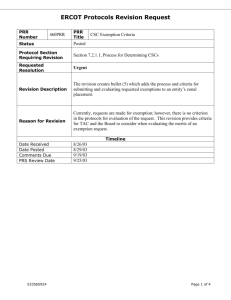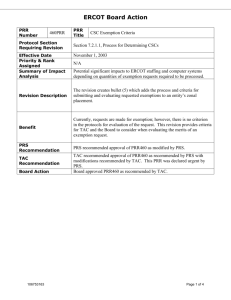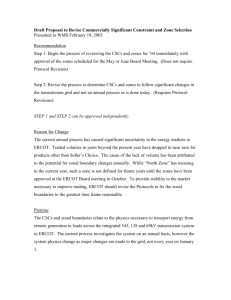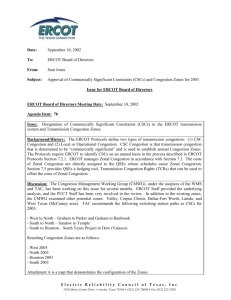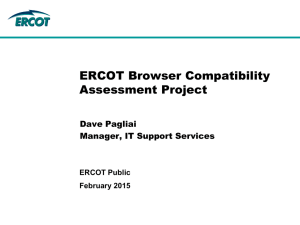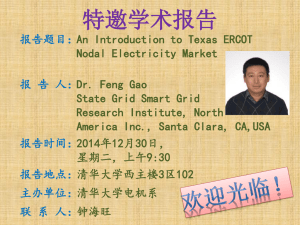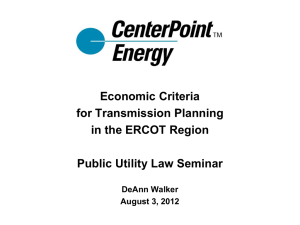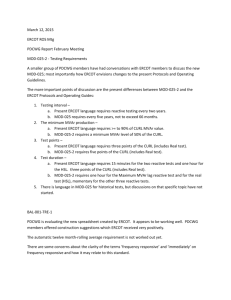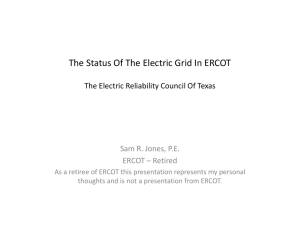CSC and Zone Determination
advertisement
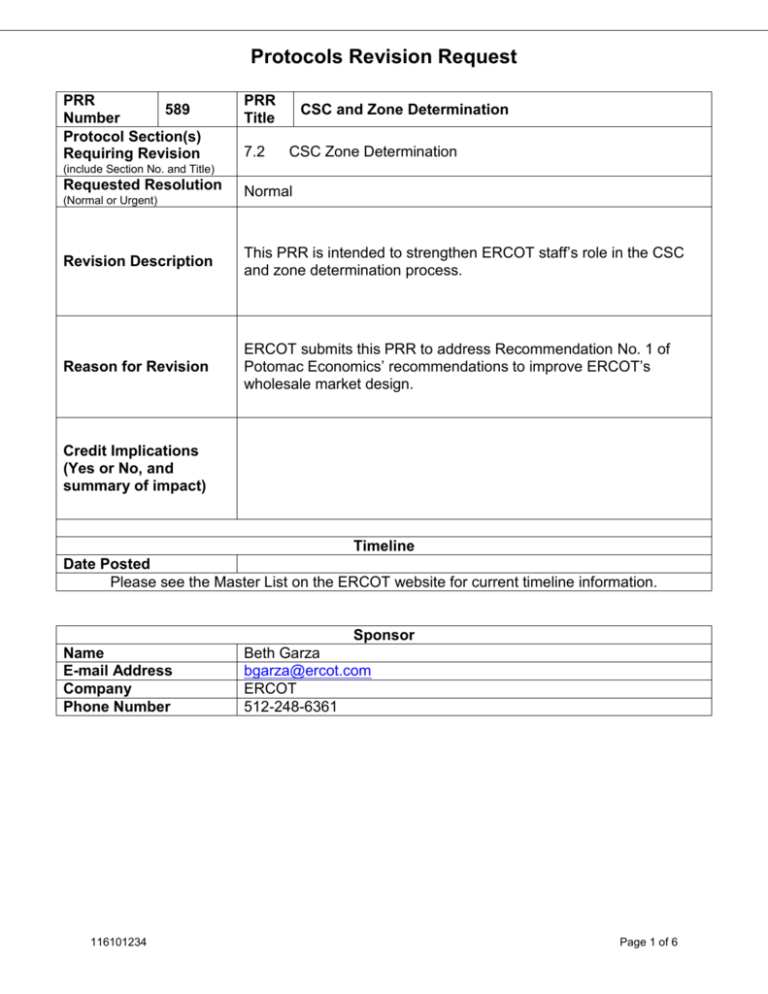
Protocols Revision Request PRR 589 Number Protocol Section(s) Requiring Revision PRR Title 7.2 CSC and Zone Determination CSC Zone Determination (include Section No. and Title) Requested Resolution (Normal or Urgent) Normal Revision Description This PRR is intended to strengthen ERCOT staff’s role in the CSC and zone determination process. Reason for Revision ERCOT submits this PRR to address Recommendation No. 1 of Potomac Economics’ recommendations to improve ERCOT’s wholesale market design. Credit Implications (Yes or No, and summary of impact) Timeline Date Posted Please see the Master List on the ERCOT website for current timeline information. Sponsor Name E-mail Address Company Phone Number 116101234 Beth Garza bgarza@ercot.com ERCOT 512-248-6361 Page 1 of 6 Protocols Revision Request ERCOT/Market Segment Impacts and Benefits Instructions: To allow for comprehensive PRR consideration, please fill out each block below completely, even if your response is “none,” “not known,” or “not applicable.” Wherever possible, please include reasons, explanations, and cost/benefit analyses pertaining to the PRR. Impact Business ERCOT MARKET SEGMENT Consumer LSE: General, Including NOIE LSE: CR & REP QSE Resource TDSP Benefit Computer Systems No impact No impact Greater over authority over CSC determination process. None Unknown None Unknown Unknown Unknown Unknown Unknown Unknown Unknown Unknown Unknown Unknown Unknown Unknown None None None Proposed Protocol Language Revision 7.2 CSC Zone Determination Process By November 1 of each year, the appropriate ERCOT subcommittee will report to the TAC and ERCOT Board with recommended CSC designations, resulting Congestion Zone boundaries, CRE designations and associated Boundary Generation Resources for ERCOT Board review and approval. Shortly after ERCOT Board approval, CSCs and resulting Congestion Zone boundaries and CRE designations will be posted on the MIS. This posting will include a station and bus-bybus identification of each Congestion Zone. 7.2.1 Process for Determining CSCs ERCOT will reassess CSCs annually, based on changes to the ERCOT System topology, and will identify new Congestion Zones based on the reassessed CSC’s by November 1 of each year. ERCOT staff will use the following process to identify CSC’s: (1) By August 1, of each year, ERCOT staff will complete an analysis of Load flow data using the latest Steady State Working Group Data Set A summer peak case and will determine expected operating limits, candidate CSCs and associated constraints to be 116101234 Page 2 of 6 Protocols Revision Request used in the designation of CSCs for the upcoming calendar year using the following steps: (a) Determination of new CSC candidates: i. Candidate CSCs can be determined using transfer analysis between Study Zones. Study Zones are groupings of buses used to test transfer limits using power system simulation tools. These Study Zones can be either of the following: (1) reasonable approximations of the final Congestion Zones; Weather Zones, SSWG Areas or Zones; or (2) any grouping of buses by geographic region or generation/Load pocket. Candidate CSCs will often be the contingency that repeatedly causes multiple limiting elements to reach 100% of their emergency rating at high transfer levels. If a transmission line is repeatedly the limiting element under multiple contingencies it will be considered a CSC candidate. ii. ERCOT will consider a directional transmission path or interface as a CSC candidate if the actual annual Congestion costs from the prior year exceed a threshold amount determined by the appropriate ERCOT subcommittee. For this purpose, Congestion costs include the cost of any zonal Balancing Energy Service, RMR Service, OOMC Service, Replacement Reserve Service, OOME Service, or Resource-specific Dispatch Instructions used to resolve Congestion on that particular transmission path in that particular direction during the prior year. ERCOT may also consider projected annual Congestion costs for the CSC designation year. Since this type of data reflects past system topology and generation, ERCOT will also consider new generation and transmission system changes expected to be in service in the CSC designation year. (b) If no new candidate CSCs are considered other than the immediately preceding year’s CSCs, then ERCOT shall use the Congestion Zones from the immediately preceding year as Study Zones. (c) If new candidate CSCs are considered, then ERCOT shall calculate Shift Factors and perform cluster analysis based on the candidate CSCs to create new Study Zones. (d) ERCOT shall perform system simulation studies with transfers between the Study Zones and find constraints on the transmission system to determine if candidate CSCs are appropriate for designation as new CSCs. (e) ERCOT shall determine whether the candidate CSCs qualify for CSC designation based, in part, on the criterion that there must be a sufficiently competitive market to resolve Congestion on the transmission path to be considered for CSC designation. For this purpose, a sufficiently competitive market will be deemed to 116101234 Page 3 of 6 Protocols Revision Request exist if Generation Resources with greater than 10% or less than -10% shift factor impacts on the candidate CSC are owned by at least three unaffiliated Generation Entities. Shift factors will be calculated using the zone on the “to” side of the CSC as reference. (2) CSC approval process: The appropriate ERCOT Technical Advisory Committee (TAC) Subcommittee will review the process followed above to determine if the list of constraints should be recommended for approval to the TAC and the Board. (3) Thirty (30) days prior to TAC review, a Non Opt-In Entity may request an exemption to its zonal placement by submitting a request to ERCOT for consideration. ERCOT staff will evaluate the merits of the request and authorize the exemption based on the following criteria: (a) Exemptions shall not cause significant operational impact to the ERCOT System. This will normally be satisfied if the request will not result in a change in the annual average Shift Factor for the original or requested Congestion Zone by more than five percent (5%) [1%?]. After the proposed move, the Zonal Shift Factor in each of the original and requested Congestion Zones shall be no less than ninety-five percent (95%) [99%?], and no more than one hundred and five percent (105%) [101%?], of its original Zonal Shift Factor before the proposed move. Because only buses with generation have an impact on the calculation of Zonal Shift Factors, if no generation exists at a bus that is part of an exemption request, a token generator of one (1) MW will be placed at that bus to test the impact of moving that bus from one (1) zone to another. This will be done to all buses that make up a request for exemption. For example, if an Entity is requesting an exemption for five (5) buses and only one (1) bus has generation On-line in the Load flow case used to test the impact, one (1) MW of generation will be placed at the four (4) other buses and the impact of all five (5) buses on Zonal Shift Factors will be determined as a group as opposed to individually. The Load flow case used to determine this impact will be the same Load flow case used to calculate annual TCR quantities. (b) 116101234 Exemptions shall not have a commercial impact/gain for the requestor. This will be measured by whether or not the scheduling which would otherwise result would be eligible for Pre-assigned Congestion Rights. Page 4 of 6 Protocols Revision Request 7.2.2 Congestion Zone & Zonal Shift Factor Determination Methodology ERCOT staff will take the following steps to determine Congestion Zones and Zonal Shift Factors: (1) Shift Factors are developed using a linearized (DC) model to identify the impact of each transmission bus on each CSC relative to an ERCOT reference bus. (2) A statistical clustering analysis will be used to aggregate transmission buses into zones based upon similar Shift Factors relative to all CSCs. To determine the appropriate number of zones, the clustering must meet the following criteria: (i) each CSC must straddle a zonal boundary (however, not every zonal boundary need be straddled by a CSC); (ii) the R2 (coefficient of determination) from the cluster analysis should be greater than a threshold level set by the appropriate subcommittee; (iii) station IDs as provided by TDSPs in Protocol Section 15.1.2.5, Response from TDSP to Registration Notification Request, can only be assigned into one Congestion Zone; and (iv) the maximum difference between the Zonal Shift Factor and the Shift Factor of any generation bus within the zone should not exceed a limit set by the same subcommittee. (3) If the clustering process described in (2) results in the splitting of two or more buses within any single station into different zones, then the following process will be used to adjust the zone selection to place all buses within a single station in the same zone: (4) (i) For Generation Resource plant stations, determine which zone contains the largest amount of generating capacity of the station and assign all buses of that station to that zone; (ii) For all other stations, determine which zone is assigned the largest total amount of Customer Load of the buses in the station and assign all buses of that station to that zone; (iii) If there is no Load or generation in the station, or if the amount of generation and/or Load assigned to individual station buses are equal, then the Load or generation shall be assigned to the zone containing the lowest bus number of the station. Zonal Shift Factors for each CSC will be determined by averaging the individual bus Shift Factors within each Congestion Zone for the corresponding CSC, weighted by the Generation Resource megawatt levels on the bus in the Load flow base case used to determine CSC Limits. The appropriate ERCOT TAC Subcommittee will determine if the above process was followed. If it was followed, the resulting Congestion Zones will be recommended for approval to the TAC and the Board. 116101234 Page 5 of 6 Protocols Revision Request 7.2.3 Determining Closely Related Elements (CREs) ERCOT staff shall determine CREs using the following process: (1) Determine the Zonal Average Shift Factor for a particular CSC (Xz) for each Zone (z). (2) Determine the zonal average Shift Factor for the candidate CRE (Yz) for each Zone z using the same generation weighting as in (1) but ignoring Boundary Generation Resource buses that would cluster into a different Congestion Zone with respect to the CRE. (3) Determine positive “a” applying least-square curve fitting to the following equation: Yz = a (Xz) + bz for all Zones z. (4) Using “a” from (3), determine the maximum absolute value of bz. (5) Also determine the total capacity (MW) of Boundary Generation Resources that would cluster into a different Congestion Zone. (6) If the maximum absolute value of bz is less than a threshold set by the appropriate TAC subcommittee, not to exceed 0.2, and the total capacity of Boundary Generation Resources that would cluster into a different Congestion Zone is less than 1,500 MW, then the element is a CRE for the particular CSC. The appropriate ERCOT TAC Subcommittee will determine if the above CRE identification process was followed. If it was followed, the resulting CREs shall be recommended for approval to the TAC and the Board. 116101234 Page 6 of 6
